JSON Connections
You can set up JSON connections in Logi Report catalogs to get data from JSON data sources. A JSON connection contains relational data which is transformed from a JSON data source.
This topic includes the following sections:
- Retrieving Data from JSON Data Sources
- Setting Up JSON Connections in a Catalog
- Adding More Tables to a JSON Connection
- Managing the Tables in a JSON Connection
- Example: Connecting a Logi Report Catalog to Google Cloud BigQuery
 Configuring Proxy for Connecting to a REST Web Service
Configuring Proxy for Connecting to a REST Web Service
Retrieving Data from JSON Data Sources
Logi Report Designer can parse JSON data to extract JSON schemas including JSON metadata (JSON objects and the relation between the objects), transform JSON schemas to relational schemas, and build relational tables during the transformation, namely map JSON object classes to tables and table columns, and build the relation between the primary and foreign keys in the tables. The tables can then be accessed in the same way as JDBC supplied tables.
Extracting Metadata from JSON Data
A JSON metadata contains a root element whose element type can be object class or object array. An object class or object array element contains some elements whose element type can be object class, object array, attribute or simple data array with the data type of String, Number or Boolean. JSON objects in an array should have the same structure, the members (name/value pairs) in an object cannot be of the same name, and for a nested array, only the first layer will be kept.
Logi Report Designer takes the following rules to extract metadata from JSON data:
- Elements should be extracted from the root value of JSON data hierarchically.
- When creating the root element, the element name is null, and the root element type is object class or object array if the root value of JSON data is an object class or an object array, else the root element type is an empty object class.
- If the value of an object member is a simple value, an attribute element will be created under current element. If it is a simple value array, a simple data array element will be created. If it is an object array, an object array element will be created. If it is an object class, an object class element will be created. The element type will be set according to the conversion rules in the Data type conversion table below. The element name is the object member name.
- All elements of the same name in object members of an object array will be merged into an element.
Before the data types defined in the JSON file can function with Logi Report Designer, they should be converted into corresponding SQL data types when Logi Report Designer extracts metadata from the JSON data, following the rules in the table below.
| JSON Data Type | SQL Data Type |
|---|---|
| String (following the format Combined date and time representations in ISO 8601) | TIMESTAMP |
| String (following JDBC Timestamp escape format) | TIMESTAMP |
| String (following the format Calendar dates in ISO 8601) | DATE |
| String (following the format Times with time zone designators in ISO 8601) | TIME |
| String | VARCHAR |
| Number (excluding fraction and exponent) | INTEGER |
| Number (including fraction and exponent) | NUMERIC |
| Boolean | BOOLEAN |
Notes:
- If the data type of all values for members of the same name in an object array is Number, including not only integer, but also fraction or exponent, the data type of all values will be converted to NUMERIC.
- If the values for members of the same name in an object array are of different data types and at least one of them is String, the data type of all values will be converted to VARCHAR.
- The values for the members of the same name in a JSON schema cannot be mixed with simple data array and single value, such as string, number,Boolean, or null, otherwise, the extracted schema maybe incorrect.
Transforming JSON Schemas to Relational Schemas
When Logi Report Designer transforms JSON schemas to relational schemas, elements in the JSON schemas are transformed to either tables or columns in tables according to the ideographic transformation rules and named according to the naming rules.
Logi Report Designer takes the following rules when transforming JSON schemas to relational schemas:
- If an object class or object array element has at least one attribute element or simple data array element, or its embedded element can be mapped to tables, the object class or object array element will be mapped to a table, and its attribute or simple data array element will be mapped to columns in the table.
- When mapping an attribute element to a column, the value of its Mapped SQL Type will be set as the value of the SQL Type of the column.
- For an embedded object class or object array element, a built-in column called foreign key will be created for the mapped table. If there is no built-in column called primary key in its parent element table, the column will be created. The SQL type of the columns primary key and foreign key is SQL type 4 (64 bit Integer).
The relational tables and columns in tables are named based on the following rules:
- For the root element, the table name is ROOT. If the name is not unique, the character _ will be added before the name one by one until it is unique.
- For elements other than the root element, the table name is the element name. If the table name is not unique, the names of the ancestor elements will be added before the table name one by one and be separated by _ until it is unique.
Setting Up JSON Connections in a Catalog
To set up a JSON connection to connect a Logi Report catalog to a JSON data source, follow the steps below:
- Create a catalog or open a catalog.
- In the Catalog Manager, right-click the node of a data source and choose New JSON Connection from the shortcut menu.
If you want to set up the connection in a new data source in the catalog, select any of the existing catalog data sources, select New Data Source on the Catalog Manager toolbar, then in the New Data source dialog, specify the name of the data source, select the JSON connection type and select OK.
The JSON Connection Wizard appears.
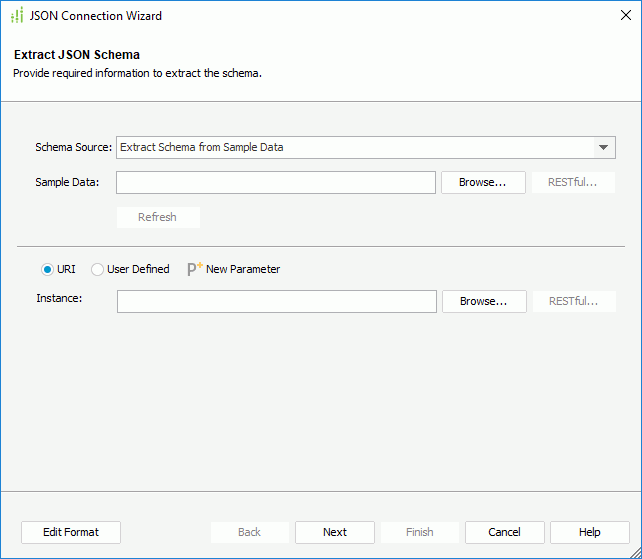
- In the Extract JSON Schema screen, select the schema source: Extract Schema from Sample Data or Extract Schema from Instance Data.
- Provide the required information for extracting the JSON schema.
- When Extract Schema from Sample Data is selected from the Schema Source drop-down list,
- In the Sample Data text box, type the URI string of the sample data file or select Browse to select the file.
In the URI string, you can reference parameters and constant level formulas in the current catalog data source and the special field User Name in the format @fieldname. For example, if a URI string is
http://localhost:8080/rest/getData?startDate=2016-01-01, and you want to use the parameters pHost, pPort and pStartDate to dynamically generate the URI at runtime, then the URI string will behttp://@pHost:@pPort/rest/getData?startDate=@pStartDate. Moreover, if a URI string contains characters, such as @, '.' or double quotation marks, or other strings that do not need to be parsed, quote them with double quotation marks. You can select New Parameter to create a parameter in the current catalog data source and reference it in the URI string. If the special field User Name is used, when selecting Next in the connection wizard, the Security Identifier dialog will pop up for you to specify the user name with which to generate the stream. When you run the report on Logi Report Server the logon user's ID will be used. - When the specified URI string begins with
http://orhttps://protocol, the RESTful button is activated. Select it to specify the RESTful options for the sample data in the RESTful Data Source Options dialog.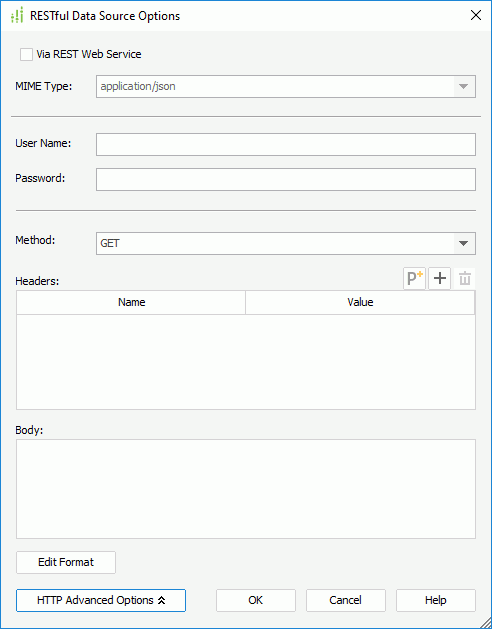
- To receive the remote data via REST Web Service, select Via REST Web Service, then from the MIME Type drop-down list, select the MIME type for the REST Web Service data source. You can also specify the type in the text box directly. The remote data will then be provided by the REST Web Services on the application server, and the REST Web Service Client API (such as JAX-RS client API of Java EE) will be used to get the remote data.
 When a proxy is used for connecting to the REST Web Service, you need to configure the proxy parameters in Logi Report so that the proxy can work successfully.
When a proxy is used for connecting to the REST Web Service, you need to configure the proxy parameters in Logi Report so that the proxy can work successfully. When Via REST Web Service is unselected, the remote data will be received via the protocol in the URL you specify in the Sample Data text box in the connection wizard.
- Specify the user name and password for remote data authentication.
- Select HTTP Advanced Options to specify the advanced HTTP options.
- Select an HTTP method from the Method drop-down list to send the request, which can be GET or POST.
- Select
 above the Headers box to add a header line, then specify the name and value of the user defined HTTP header. Repeat this to edit more headers.
above the Headers box to add a header line, then specify the name and value of the user defined HTTP header. Repeat this to edit more headers. - In the Body box, specify the user defined HTTP body.
- When editing the HTTP headers and body, you can reference parameters and constant level formulas in the current catalog data source and the special field User Name in the format "@fieldname". You can select
 to create a parameter in the current catalog data source and reference it in the header or body. When parameters and formulas are referenced, you can select the Edit Format button to edit the format of their values.
to create a parameter in the current catalog data source and reference it in the header or body. When parameters and formulas are referenced, you can select the Edit Format button to edit the format of their values. - Select OK to apply the specified RESTful data source options and return to the JSON Connection Wizard.
- Specify how to get the instance data.
To use instance data from a URI, select the URI radio button, then type the URI string in the Instance text box or select Browse to select the instance file. You can also reference parameters, constant level formulas and the special field User Name in the URI string. When the specified URI string begins with
http://orhttps://protocol, the RESTful button is activated. Select it to specify the RESTful options for the instance data.To use instance data from a user defined interface, select User Defined, then provide the class name with package name in the Class Name field. You can also select Browse to find the class file. The class you specify should exist and can be found by Logi Report Designer, which means the class should be in the class path of the system environment or in the ADDCLASSPATH in setenv.bat/setenv.sh. After filling in this field, the class name of the interface that the class implements will be displayed automatically behind "The class implements:". Then specify the parameter string for the user defined interface in the Parameter box. The parameter string must match the format defined in the class. You can also reference parameters, constant level formulas, and the special field User Name in the parameter string.
- In the Sample Data text box, type the URI string of the sample data file or select Browse to select the file.
- When Extract Schema from Instance Data is selected from the Schema Source drop-down list, type the URI string of the instance file in the Schema Name text box or select Browse to select it. In the URI string, you can reference parameters, constant level formulas and the special field User Name. When the specified URI string begins with
http://orhttps://protocol, the RESTful button is activated. Select it to specify the RESTful options for the instance data.
- When Extract Schema from Sample Data is selected from the Schema Source drop-down list,
- When parameters and formulas are referenced in the URI/parameter string, you can select the Edit Format button to edit the format of their values.
- Select Next to go to the next screen.
- In the Modify Schema Properties screen, the elements in the JSON schema are listed in the Schema box. Select an element and modify its properties in the Properties box as required and then select Next.
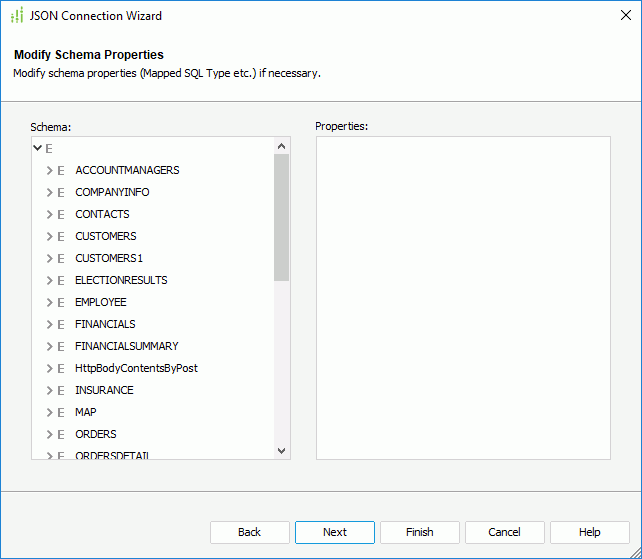
- In the Transformed Relational Schema screen, the relational tables built based on the transformed relational schema structure are listed. Check the transformed result listed in the Transformed Tables box, and then select Next.
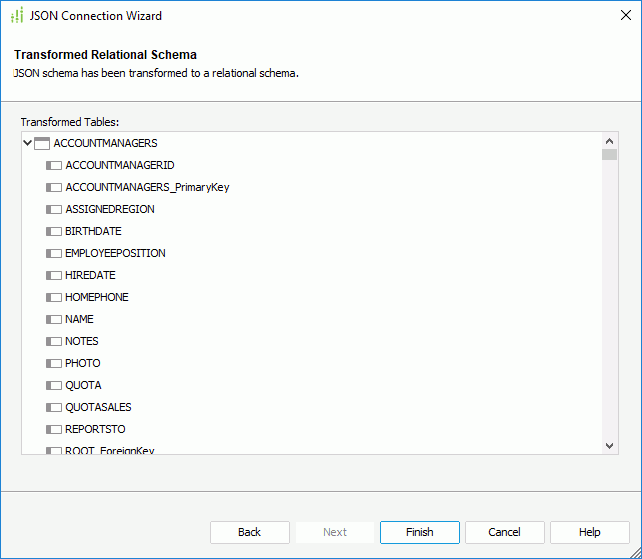
- In the Add Table screen, add the required tables to the connection.
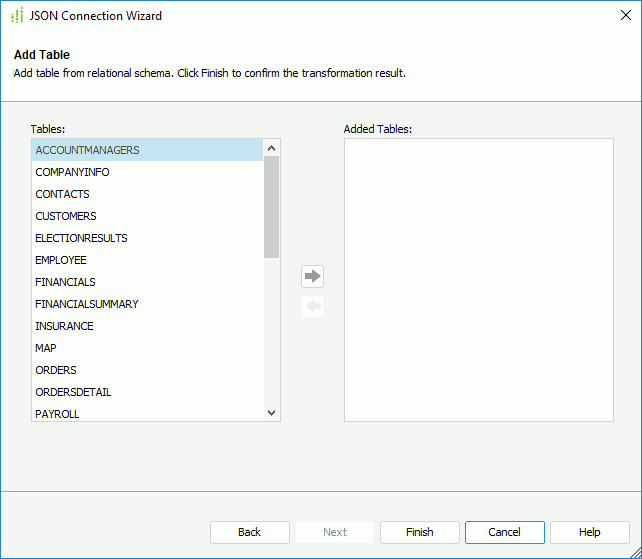
Queries and business views are created on tables and a report is developed from a query (or something else which is functionally similar) or from a business view.
- Select Finish to confirm the transformed result and complete the transformation process.
Adding More Tables to a JSON Connection
When a JSON connection is set up, you can add more tables transformed from the JSON data source into the Logi Report catalog via the JSON connection.
- Do one of the following:
- Right-click the JSON connection and select Add Tables from the shortcut menu.
- Right-click the Tables node of the JSON connection and select Add Tables from the shortcut menu.
- Right-click an existing table in the JSON connection if there is and select Add Tables from the shortcut menu.
- Right-click any folder in the Tables node of the JSON connection if you have already created some and select Add Tables from the shortcut menu.
- Select the Tables node of the JSON connection, or any existing table or folder in the connection and select Add Tables on the Catalog Manager toolbar.
The Add Tables dialog appears.
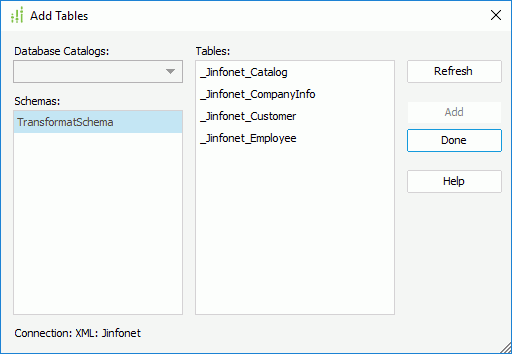
- Select the Refresh button. The tables contained in the schema that is transformed from the JSON file will then be displayed in the Tables box.
- Choose the required tables in the Tables box, and then select Add.
To choose consecutive tables, select the first table, press and hold down the SHIFT key, and then select the last table. To choose tables that are not consecutive, press and hold down CTRL, and then select each table.
- After adding the required tables, select Done to close the dialog.
Managing the Tables in a JSON Connection
For the tables that have been transformed from a JSON data source and added into a Logi Report catalog via the specified JSON connection, you can refresh them, organize them into folders, and remove and add the table columns the same as you do on tables from a JDBC database.
Example: Connecting a Logi Report Catalog to Google Cloud BigQuery
In the following example, we will set up a JSON connection to connect a Logi Report catalog data source to Google Cloud BigQuery. In this example, we will create two parameters in the Logi Report catalog and use them to provide values for the two tokens access_token and maxResults in the URL of the JSON instance file used to access Google Cloud BigQuery. The token access_token is for authorizing a Google API request, and maxResults represents the maximum record number to return. You can change the parameter values to provide dynamic values for the two tokens at runtime.
- Make sure SampleReports.cat is the currently open catalog file. If not select File > Open Catalog to open it from
<install_root>\Demo\Reports\SampleReports. - Right-click the Parameters node in Data Source 1 of the catalog and select New Parameter from the shortcut menu.
- In the New Parameter dialog, type pAccessToken in the Name text box.
- Select String from the Value Type drop-down list.
- Select
 to add a value line, double-click in it and then type in the valid token value to access Google Cloud BigQuery, for example, ya29.Ci9dA2sA8J_wM8e5FnY9rJg551153GQWGbleO-y9aeZOky9V36Tz497HY1chApjLFg.
to add a value line, double-click in it and then type in the valid token value to access Google Cloud BigQuery, for example, ya29.Ci9dA2sA8J_wM8e5FnY9rJg551153GQWGbleO-y9aeZOky9V36Tz497HY1chApjLFg. - Select OK to create the parameter.
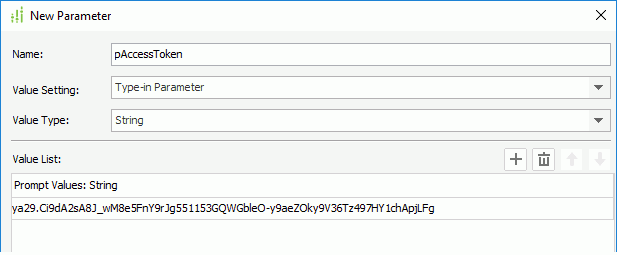
- Repeat the above steps to create another parameter pMaxResults of Integer type with the prompt value 2 in the Value List.
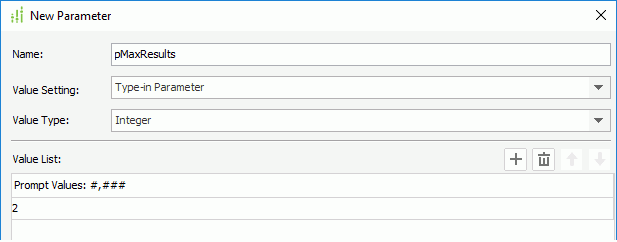
For more information about creating parameters, see Creating a Parameter.
- Right-click the Data Source 1 node and select New JSON Connection from the shortcut menu. The JSON Connection Wizard appears.
- In the Extract JSON Schema screen, select Extract Schema from Instance Data from the Schema Source drop-down list.
- Type the following URL in the Instance text box:
https://www.googleapis.com/bigquery/v2/projects/bigquery-public-data/datasets/samples/tables/gsod/data?maxResults=@pMaxResults&access_token=@pAccessToken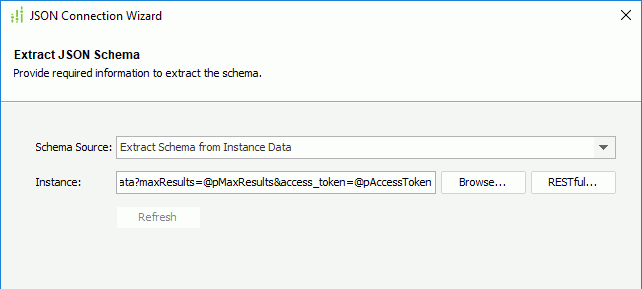
- Select Next three times to go to the Add Table screen. Select f in the Tables box and select
 to add it to the Added Tables box.
to add it to the Added Tables box. - Select Finish to set up the connection.
 Configuring Proxy for Connecting to a REST Web Service
Configuring Proxy for Connecting to a REST Web Service
In a restricted network when a proxy is used for connecting to a REST Web Service as the data source, you can set the proxy parameters in a configuration file in Logi Report so as for the proxy to work successfully. You need manually create the configuration file in the XML format, named restdsproxy.xml, in the directory <install_root>\bin.
The following is an example of the configuration file and the detailed description of each tag in the file:
<?xml version="1.0" encoding="UTF-8"?>
<restdsproxy>
<proxymapping>
<urlpattern>https://.*\.jinfonet\.com/</urlpattern>
<proxyhost>192.0.0.14</proxyhost> <proxyport>8888</proxyport> <user>user1</user>
<password>psw1</password>
</proxymapping><proxymapping>
<urlpattern>http://.*\.jinfonet\.com\.cn/</urlpattern>
<proxyhost>192.0.0.14</proxyhost> <proxyport>80</proxyport> <user>user2</user>
<password>psw2</password>
</proxymapping>
</restdsproxy>
- restdsproxy
The root tag that contains one or more <proxymapping> sub-tags. - proxymapping
Represents the whole set of parameters of a proxy. It contains the following sub-tags each defining a specific proxy parameter. - urlpattern
A regular expression string supported by Java that matches the URL of a REST Web Service. If there are multiple URL patterns that match the same URL, the proxy setting in the <proxymapping> tag that contains the first one matched will take effect. - proxyhost
The host name or IP address of the proxy. - proxyport
The port number of the proxy. - user
The user name used for the proxy authentication. It is optional. - password
The password used for the proxy authentication. It is optional.
Note: The <user> and <password> information is encrypted, and replaced by the <encrypt-sign> tag after Logi Report starts up as follows:
<encrypt-sign>enDkq7srM9cHhoUwzYXJ3NvcDIYk</encrypt-sign>
If you want to change the user or password, delete the <encrypt-sign> tag and then add the <user> and <password> tags in the restdsproxy.xml.
 Previous Topic
Previous Topic